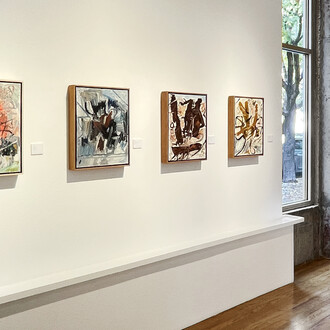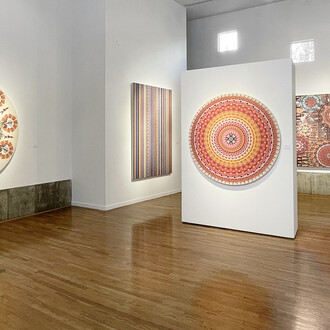Robischon Gallery is pleased to present acclaimed California artist David Maisel’s, “Atlas,” the artist’s first Robischon Gallery exhibition featuring photography from both new and earlier series. The photographs address globally important environmental concerns as revealed in the five series on view created over a nearly thirty-year span between 1989 and 2018 including the most recent “Desolation Desert” and the artist’s earlier series: “The Lake Project,” “American Mine,” “Terminal Mirage” and “The Mining Project.” Focusing on sites primarily located in the United States, along with those images recently captured in South America, the complex and questionable politics of radically human-altered environments are unavoidably illuminated as Maisel presents the breathtaking drama of terrain which is designated as off-limits, quarantined or otherwise hidden from view. Astonishing in scale, the vastness of the sites is at first difficult to perceive, but it is in Maisel’s chosen views that the photographs become painterly abstractions of coalescing forms in lush colors of orange, crimson, aqua and sapphire. Even as the artist’s elevated view of his subjects from inside the aircraft imparts a dramatic beauty to the riven landscapes, they also expose the unparalleled pace at which remote areas are ruthlessly co-opted by industry to satisfy an insatiable human desire. As the title suggests, Maisel’s work has long focused on accumulating an atlas of sorts to make a record of the escalating earthly transformations.
Historically, mining operations in the Atacama Desert of Chile, shown in Maisel’s “Desolation Desert” series, have taken the form of enormous open pits devoted to the exploitation of copper reserves. With shifts of co-mingling soft slate blues and grays, Desolation Desert: Tailings Pond 3, with its delineating white cross-hatched elements from stone levees, presents a serene image which invites further exploration. Even as Chile remains the world’s top producer of copper, in the past decade, a surge in lithium mining has further imperiled the environment of the Atacama region. Lithium’s unique properties – it is the lightest of all metals, heat resistant, and can store substantial amounts of energy in batteries for computers, cell phones, and cars – have fueled a global rush to extract it so that with rising demand, lithium prices have nearly tripled in the past three years alone. Such demand will only increase as electric cars become more common – creating a conundrum with electric cars as the heralded solution to phasing out of fossil-fueled vehicles. Maisel states, “I am captivated by the ways in which the industrialization of the Atacama and the resulting environmental challenges are representative of our radical transformation of the earth and our understanding of our place within it. These images of the Atacama are intended to counter our collective misapprehension of the desert as a terra incognita, a vast emptiness upon which we impose a notion of purity and boundlessness. Forming part of an alternative cartography that maps industrial development beyond the city limits, these new photographs show how the once remote Atacama Desert is becoming part of a planetary fabric of urbanization, and at what cost.”
Similarly, the photographs of Maisel’s series entitled “The Lake Project,” exposes the man-made transformation of California’s Owens Lake, the site of a formerly 200-square mile lake which, while still suppling some water to Los Angeles, has become so depleted that much of it is an arid wasteland where winds dislodge particles from the lakebed to create carcinogenic dust storms. The remaining mineralized water hosts blooms of microscopic bacteria that turns the remaining water a deep, blood red color. Images comprised in some sense as if exclusively formal abstraction, the artist’s selected view of The Lake Project 1, is a composition of asymmetric forms with sweeps of red merging with ochre and white and in The Lake Project 20, a sinuous red linear element winds through a lavender field. Ironically, in direct contrast to its appearance as an overtly abstracted image, the lake has become, as the artist says, “the locus of water’s absence” and at the same time, “a strange beauty born of environmental degradation.”
“American Mine” and “The Mining Project” series both examine the consequences of natural resource extraction under federal mining laws. Originating in 1872, the laws facilitated Manifest Destiny – an approach toward developing the West in order to exploit its abundance, resulting in environmental impacts which leave mining sites deeply scarred and contaminated today. Maisel’s “The Mining Project” considers places like the Berkeley Mine in Butte, Montana, whose open pit is filled with severely poisoned water a mile deep and nine hundred feet wide – yet through Maisel’s lens, truth and beauty become one as the artist renders a surreal photograph of cerulean blue and forest green creating a space for contemplation and awakening. His American Mine series features open pit mines on the Carlin Trend, the most prolific gold mining district in the Western Hemisphere with the series represented by American Mine (Carlin, Nevada 18) – a bold, primarily three-element composition of grass green suffusing into rust-orange over white. It is critical to note that mines from this region are the source of devastating mercury emissions released when ore is heated during the process of gold extraction. Both of the artist’s series depict the calamitous practice of cyanide and sulfuric acid heap leaching, employed to extract microscopic particles of precious metals from mined ore, which often permit deadly solutions to contaminate surrounding groundwater. The extracted metals, however, are used to manufacture products for daily use. Maisel notes, “our infrastructure, our technology, our transportation systems, and even the medium of photography itself, are all reliant on metals extracted from the Earth’s crust in methods both brutal and complex. As citizens of an entrenched consumer society, we are collectively complicit in the creation of these depleted and damaged landscapes.” With deep consideration, Maisel’s photographs seek to give visual form to the disquieting relationship between contemporary humanity and the Earth; between consumer and consumed.
Inspired by Robert Smithson, the well-known earthwork artist who wrote inspired treatises on the Great Salt Lake and railed against conventional art exhibitions, Maisel embarked upon an aerial survey of this surreal, apocalyptic, and strangely beautiful region that is the home of Smithson’s iconic Spiral Jetty. “Terminal Mirage” examines the periphery of Utah’s Great Salt Lake, also including zones of mineral evaporation ponds and macabre industrial pollution covering some 40,000 acres along the shores of the lake. The artist observes that with each layer of human intervention, the landscape becomes more complex. Previous scars are covered over, and cycles of negation and erasure expand into a grid system overlaid on the barren lake. The colorful poignant view of Smithson’s graceful spiral through the lens of Maisel continues his thoughtful engagement.
In “Atlas,” as in all of the artist’s provocative and mesmerizing featured aerial photographic series, a new map emerges from the disruption and humanity’s collective place within it. The artist notes that, “these depictions of damaged wastelands, where human efforts have eradicated the natural order, are both spectacular and horrifying. Although the photographs are evidence of the devastation of these sites, they also transcribe interior, psychic landscapes that are profoundly disturbing. As otherworldly as the images may seem, they depict shattered realities of our own making.” David Maisel’s complex and adventurous, image-making process is a singular response to humankind’s often-devastating mark on the land, but it also offers an immersion into the artist’s distinctive vision – a blending of a soulful sense of abstraction, nature and global stewardship.
David Maisel has an MFA from California College of the Arts, a BA from Princeton University and he also studied at Harvard University’s Graduate School of Design. He is a recipient of a prestigious 2018 Guggenheim Fellowship in the Creative Arts; a 2011 Investing in Artists Grant from the Center for Cultural Innovation; a 2008 Artist in Residence at the Headlands Center for the Arts; a 2007 Scholar in Residence at the Getty Research Institute; a 1990 Individual Artists Grant from the National Endowment for the Arts; and a 1984 Francis LeMoyne Page Award in the Visual Arts from Princeton University. Maisel was named to the Yerba Buena Center for the Arts 100 in 2015, and was a finalist for the 2008 Prix Pictet Award in Photography and the 2008 Herb Alpert Award in the Arts. Maisel has been a Trustee of the Headlands Center for the Arts since 2011, and serves on the California College of the Arts President’s Alumni Council. His work is in the permanent collections of the Denver Art Museum and the University of Colorado Museum of Art, Boulder, CO and prestigious museums throughout the US including: San Francisco Museum of Modern Art, CA, Metropolitan Museum of Fine Art, NY, Museum of Fine Art, Houston, TX, Los Angeles County Museum of Art, Nevada Museum of Art, Reno, NV, Brooklyn Museum of Art, NY, Getty Museum, CA, Victoria and Albert Museum, London, UK, Harvard University Fogg Museum of Art, Cambridge, MA and Yale University Art Gallery, New Haven, CT, among notable other institutions of merit.
















